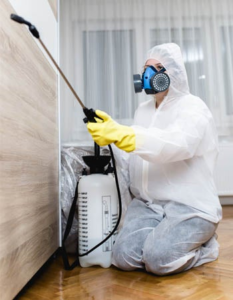Services homes and businesses for pests including ants, earwigs, spiders, mice and fleas. Offers preventative service year round and treatment for emergencies. Has high safety standards and trained specialists. For more information, click the Pezz Pest Control to proceed.
Threshold-based decision making – observing a few insects may not warrant action, but seeing more could indicate an infestation. Physical barriers and traps can be effective, such as removing food sources and putting tight lids on garbage bins.

Whether a pest is a plant, animal, or microbe, correct identification of the problem is essential to planning effective control tactics. Misidentification may lead to unnecessary or ineffective treatment or even harming the wrong target organism. In some cases, precise pest identification may require consultation with an expert or even sending samples to a lab. But the savings in time, money and potential environmental risks is well worth the effort.
A good starting point for pest identification is to look at the damage being caused. Holes in leaves, curling or distorted leaves or flowers, or the presence of ants, beetles, and caterpillars are often signs of pest problems. Other clues include the presence of larvae, egg masses, or feces. In some cases, the damage is a result of direct feeding by the pest or indirect damage from the pest transmitting pathogens to the plant.
Another important step in pest control is to identify the pest’s natural habitat. This will help in determining the best type of bait or trap to use and where to place them. In addition, it will help in identifying the pest’s breeding sites, so that they can be removed or blocked.
Many pests need water and/or food to survive, so eliminating their sources of attraction is another key to successful pest control. This includes keeping food in containers, picking up spills and crumbs, and moving bird feeders and baths away from the house to prevent pests from seeking shelter inside. Ensure that outdoor garbage is properly stored and sealed, and that the yard is free of debris that pests can hide under or in.
Regular inspection of the home is also critical to effective pest control. Screening windows and doors, patching holes in the foundation, roof or utility lines, and removing rotten tree stumps and logs can all make your property less attractive to pests. Regular inspections should be made of all potential entry points to the house, including under eaves and behind siding. Preventative measures such as these will allow you to detect pests before they become a serious problem, and may even save you the cost of professional pest control services.
Pest Prevention
Pests can cause a number of problems in and around buildings. They may damage structures, contaminate food or make people sick. Some pests, like rats and cockroaches, can even trigger asthma and allergies in some people.
Although eradication of pests is a goal in some cases, the main purpose of pest control is prevention. This is because it is less costly and more environmentally friendly to prevent pests from entering an area than it is to remove them once they are there. Pest control is especially important in enclosed environments, such as homes; schools; offices; retail and food preparation areas; and health care, livestock, and veterinary facilities.
The key to pest prevention is cleanliness. This means wiping, mopping or vacuuming surfaces frequently to get rid of crumbs and other materials that can attract pests. It also means keeping garbage receptacles closed and emptied regularly, and storing or disposing of waste properly.
Other prevention measures include controlling the movement of pests by eliminating their access to food, water and shelter. For example, by blocking entry points and sealing cracks and crevices in walls and around pipes and drains. It is also important to know the lifespan and life cycle of a pest, as some interventions are only effective at certain stages. This information can help determine the type and timing of an intervention, as well as the choice of a method.
Building occupants can also contribute to pest prevention by reporting maintenance problems to managers or owners and keeping living spaces clean. This can help reduce the presence of pests, such as pigeons, roaches and bed bugs, which are known to trigger allergies in some people.
When a pest infestation does occur, it is important to act quickly and decisively. It is also important to follow proper procedures for handling and applying pesticides, so that they are not accidentally inhaled or ingested. It is particularly important to use only the amount of a pesticide needed, as overuse can create resistance and allow the pests to adapt to the poison. Also, a pesticide should never be used in the vicinity of an individual who is sick or has an allergy to the substance.
Pest Control Methods
Physical pest control methods involve blocking or removing a pest’s access to food, water, shelter or breeding ground. This includes things like sweeping and mopping floors to remove food debris, dirt and dead skin cells, which offer nutrients to cockroaches. It also involves eliminating dark, damp and warm spots that provide hiding places for pests. Cleaning up rubbish and recycling regularly and reducing clutter are also important physical pest control measures. Regularly checking and fixing holes in windows, doors and the garden is essential.
In some cases, preventing the development of pests may be possible, especially with sporadic pests such as plant diseases that only occur under certain environmental conditions. Cultural controls such as crop rotation, choosing resistant varieties and adjusting irrigation practices can help prevent the development of disease-causing organisms in crops.
Chemical pest control uses pesticides to kill or deter pests. The choice of pesticide will depend on the kind of pest and its environment. It is important to understand that any pesticide will also have an impact on other organisms, including beneficial ones. This is why the use of pesticides must always be carefully planned and monitored.
Fogging machines can be used to spray insecticides over large areas in an environmentally-friendly manner. This can be effective against flying insects such as moths and flies. Rodenticides, which are toxic to rats and other mammals, can be used in specially-designed baits to prevent other animals from ingesting them.
The use of fungicides is also common in gardening and farming to prevent or treat fungal infestations. Microorganisms such as the bacterium Bacillus thuringiensis (Bt) are often used in agricultural settings to kill caterpillars by producing a protein that is harmful to them, but which does not affect other plants or animals.
Preventing pests is a lot easier than controlling them once they have become a problem. Prevention is the most important part of an integrated pest management (IPM) strategy, so take the time to identify a problem and consider what you can do to stop it happening again. The more you know about the pest, its environment and what makes it tick, the better equipped you are to come up with a suitable plan of attack.
Pesticides
Pesticides are chemicals that kill unwanted organisms such as insects, weeds, mildew, rodents and fungus. They come in many forms, including liquids, powders and sprays. There are also biological pesticides, which use living organisms to control pests (such as bacteria that kill weed seeds).
Before using any pesticide, it is important to try non-chemical methods first. Then, if you must use a pesticide, make sure it is the correct product for the job and that you follow the directions on the label. It is also important to store and dispose of pesticides properly.
If you do have to use a pesticide, it is important to minimize the amount you apply. The more pesticide you use, the greater the risk to the environment and human health. Also, pests often develop resistance to pesticides. Therefore, it is important to apply the lowest effective rate as recommended on the pesticide label.
When applying pesticides, always read and follow the directions and safety warnings on the product label. Also, have a plan before starting any pesticide project. This should include identifying the pest and determining the best way to eliminate it. Also, plan on destroying any shelters and breeding sites of the pest (e.g., clearing brush). It is also important to use pesticides sparingly and only where necessary.
The form of the pesticide and how it is applied will determine its impact on the environment. For example, powders and liquids are less likely to drift than aerosol sprays. Also, biodegradable pesticides break down more quickly than persistent ones in the soil.
Most synthetic and botanical insecticides have very specific modes of action. These affect the nervous system or development of the pest. As a result, they can also have toxic effects on humans and other animals.
Increasingly, scientists and farmers are using less harmful products with less adverse impacts on the environment. These may be derived from plant products, such as oils and enzymes or produced by microorganisms such as Bacillus thuringiensis (Bt). They are generally less acutely toxic than most synthetic pesticides. In addition, they can be used with a lower application rate to reduce the likelihood of developing pesticide resistance.





